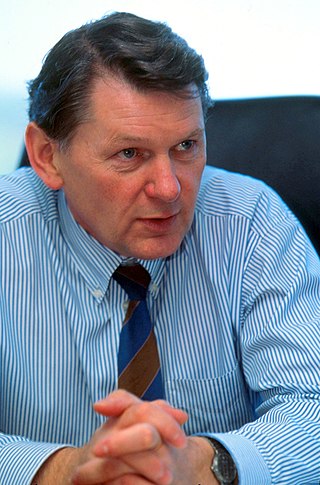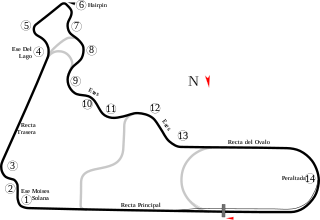
Cosworth is a British automotive engineering company founded in London in 1958, specialising in high-performance internal combustion engines, powertrain, and electronics for automobile racing (motorsport) and mainstream automotive industries. Cosworth is based in Northampton, England, with facilities in Cottenham, England, Silverstone, England, and Indianapolis, IN, US.

Benetton Formula Ltd., commonly referred to simply as Benetton, was a Formula One constructor that participated from 1986 to 2001. The team was owned by the Benetton family who run a worldwide chain of clothing stores of the same name. In 2000, the team was purchased by Renault, but competed as Benetton for the 2000 and 2001 seasons. In 2002, the team became Renault. The Benetton Formula team was chaired by Alessandro Benetton from 1988 to 1998.

John Edward Barnard, is an English engineer and racing car designer. Barnard is credited with the introduction of two new designs into Formula One: the carbon fibre composite chassis first seen in 1981 with McLaren, and the semi-automatic gearbox which he introduced with Ferrari in 1989.

The DFV is an internal combustion engine that was originally produced by Cosworth for Formula One motor racing. The name is an abbreviation of Double Four Valve, the engine being a V8 development of the earlier four-cylinder FVA, which had four valves per cylinder.

The 1988 Mexican Grand Prix was a Formula One motor race held on 29 May 1988 at the Autódromo Hermanos Rodríguez, Mexico City. It was the fourth race of the 1988 Formula One World Championship. The 67-lap race was won by Alain Prost, driving a McLaren-Honda, with teammate Ayrton Senna second and Gerhard Berger third in a Ferrari.

The 1990 German Grand Prix was a Formula One motor race held at the Hockenheimring on 29 July 1990. It was the ninth race of the 1990 Formula One World Championship. The race was the 52nd German Grand Prix and the 14th to be held at the Hockenheimring. It was the 39th and last Formula One Grand Prix to be held in West Germany prior to its re-unification with East Germany. The race was held over 45 laps of the seven kilometre circuit for a race distance of 306 kilometres.

The 1988 FIA Formula One World Championship was the 42nd season of FIA Formula One motor racing. It featured the 1988 Formula One World Championship for Drivers and the 1988 Formula One World Championship for Constructors, which were contested concurrently over a sixteen-race series that commenced on 3 April and ended on 13 November. The World Championship for Drivers was won by Ayrton Senna, and the World Championship for Constructors by McLaren-Honda. Senna and McLaren teammate Alain Prost won fifteen of the sixteen races between them; the only race neither driver won was the Italian Grand Prix, where Ferrari's Gerhard Berger took an emotional victory four weeks after the death of team founder Enzo Ferrari. McLaren's win tally has only been bettered or equalled in seasons with more than sixteen races; their Constructors' Championship tally of 199 points, more than three times that of any other constructor, was also a record until 2002.

The 1984 FIA Formula One World Championship was the 38th season of Fédération Internationale de l'Automobile (FIA) Formula One motor racing. Drivers and teams competed in sixteen Grands Prix for the World Drivers' and World Constructors' championship titles. The season ran from 5 March to 21 October.
Teodorico Fabi is an Italian former racing driver. He competed in Formula One, IndyCar, and sports car racing. He claimed pole position in his rookie year at the 1983 Indianapolis 500. Teo is the older brother of former Formula One driver Corrado Fabi.
Motori Moderni was a Formula One engine manufacturer from 1985 through 1987. It was established by the experienced Italian engine designer Carlo Chiti.

The McLaren MP4/2 was a Formula One car produced by McLaren for the 1984 season. An iteration of it, the MP4/2B, was used in the 1985 season, and a slightly updated version, the MP4/2C, raced in the 1986 season for McLaren. It was closely based on the MP4/1E model that was used as a test car, used in the final races of 1983.

The McLaren MP4/8 was the Formula One car with which the McLaren team competed in the 1993 Formula One World Championship. The car was designed by Neil Oatley around advanced electronics technology; including a semi-automatic transmission, active suspension, two-way telemetry, and traction control systems, that were developed in conjunction with McLaren shareholder Techniques d'Avant Garde (TAG). It was powered by the 3.5-litre Ford HBD7 V8 engine and was the first McLaren to feature barge boards. The McLaren MP4/8 was also first Ford-powered McLaren car since McLaren MP4/1C in 1983.

The Ferrari 641 was the Formula One racing car with which the Ferrari team competed in the 1990 Formula One World Championship. Driven by Alain Prost and Nigel Mansell, it won six Grands Prix.

The Ferrari F1/86 was the car with which Scuderia Ferrari competed in the 1986 Formula One World Championship. The car was designed by Harvey Postlethwaite, who had also designed its predecessor, the 156/85. It was driven by Italian Michele Alboreto and Swede Stefan Johansson. The car was very uncompetitive, despite the engine being regarded as one of the strongest on the grid. It was replaced by the Ferrari F1/87 for 1987.

The Benetton B186 is a Formula One racing car, built and raced by the Benetton team for the 1986 Formula One World Championship. It was the first car to be constructed and raced by Benetton, which had bought the Toleman team at the end of 1985 after several years of sponsoring it and other teams, including Alfa Romeo and Tyrrell.

The Benetton B188 is a Formula One racing car designed by Rory Byrne and raced by Benetton team in the 1988 Formula One season and in the first half of the 1989 Formula One season. Dating back to when the team started as Toleman in 1981, the B188 was the first car produced by the team not to be powered by a turbocharged engine.

The Benetton B189 is a Formula One racing car designed by Rory Byrne and raced by the Benetton team in the 1989 Formula One season. The car replaced the B188 that had been in use from the 1988 season.

The Benetton B191 is a Formula One racing car, with which the Benetton team competed in the 1991 Formula One season and at the beginning of 1992. Designed by John Barnard and Mike Coughlan, the car made its debut at the 1991 San Marino Grand Prix, driven by two Brazilian drivers, three-time World Drivers' Champion Nelson Piquet and Roberto Moreno. The B191 was powered by the Ford HBA5 V8 engine in an exclusive deal with Ford, and ran on Pirelli tyres. Following the Belgian Grand Prix the team replaced Moreno with German newcomer Michael Schumacher.

The Benetton B187 is a Formula One racing car designed by Rory Byrne and raced by the Benetton team in the 1987 Formula One World Championship. The B187 replaced the B186 used in the 1986 season.

The HB is a series of 3.5-litre, naturally-aspirated V8 Formula One racing engines, designed, developed and produced by Cosworth, in partnership with Ford; and used between 1989 and 1994. The customer engines were used by Benetton, Fondmetal, McLaren, Lotus, Minardi, Footwork, Simtek, and Larrousse.




















